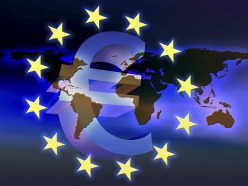
Will there be a tighter or looser monetary union in the eurozone in 10 years? What steps should be avoided in dealing with the eurozone debt crisis? These are some of the questions Jens Larson, RBC’s top economist in Europe, addressed at an Economic Club of Canada lunch in Toronto.
The ‘no-go’ solutions
Larson rules out the default option because it will cause heavy losses across the eurozone, which is simply too risky at this stage of the game. Moreover, “the politics of default in Europe are very ugly indeed.”
So why not just throw in the towel and move in the direction of dismantling the union? “This isn’t politically feasible,” Larson argues, “because the European political fabric is knitted tightly around integration, and changing direction would have enormous political costs. More importantly, it doesn’t address the underlying economic issues. It would be an enormously costly action economically both for the core and the periphery.”
“I think it’s against the interests of all eurozone countries to even contemplate breaking up the union,” he adds.
What, then, of taking the complete opposite tack, namely a monetary union with a complete fiscal union? In this scenario the eurozone countries would have a common fiscal policy, and the responsibility for debt would be shared by all countries. “This is, for good reason, politically unfeasible,” Larson says.
“There’s no desire among German, Finnish or Dutch taxpayers to pick up the tab for Greek fiscal exuberance. Such a union would institutionalize the very things that helped create the crisis in the first place.”
Some have floated the idea of inflating the debt away — the approach of choice for many governments in the past when they’ve gotten into this kind of trouble. Larson says this approach doesn’t work well when your central bank is committed to price stability. “They aren’t going to play along in any game to try to ease the debt burden by allowing high inflation,” he says.
What’s the plan?
Larson is impressed with some of the steps taken by European leaders thus far. “After a slow start, European leaders have in the course of the crisis taken a number of policy initiatives, some of which I think are truly impressive. A key element here is a much deeper economic coordination and surveillance framework that should in the future prevent eurozone countries’ imbalances from getting out of hand,” he says.
Larson notes Europe will be running a second round of bank stress tests to determine whether the banks are able to withstand further losses. “If they’re not, they’ll be recapitalized, and that should create more confidence in the banks and reduce uncertainty about the size and location of the exact losses.”
Larson points out, however, that there’s a good deal of skepticism around whether the tests will be effective. When similar tests were conducted last year, “they weren’t at all successful in creating confidence, unlike in the U.S.”
The most important step, in Larson’s assessment, is Europe’s new crisis resolution framework.
“It will work pretty much like a mini IMF within the euro area. Importantly, any assistance that’s going to be offered will be conditional on the debt burden of the country being sustainable,” he says.
Taken together, these steps should “buy enough time to allow countries to adjust and grow their way out of trouble,” Larson says, adding that “it could take an awfully long time and will involve substantial pain. It may also involve some restructuring of debt, but hopefully only once.”
Wrapping up his assessment, Larson predicts a much tighter monetary union in 10 years’ time, with a much stronger governance framework. The euro will not fall, and there won’t be more than one currency in the euro area, he suggests.
“The crisis at this point is unlikely to spread any further, but there’s a lot of work to do in handling it,” Larson concludes.